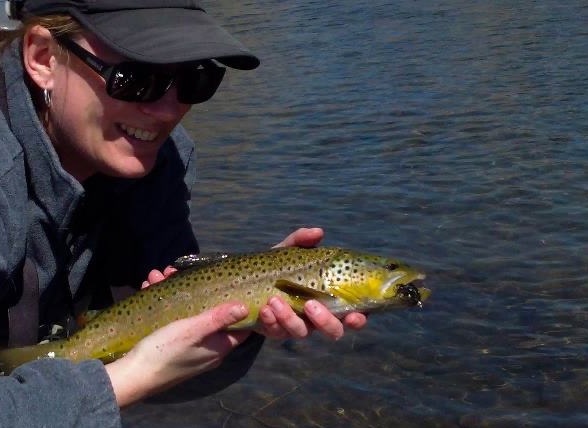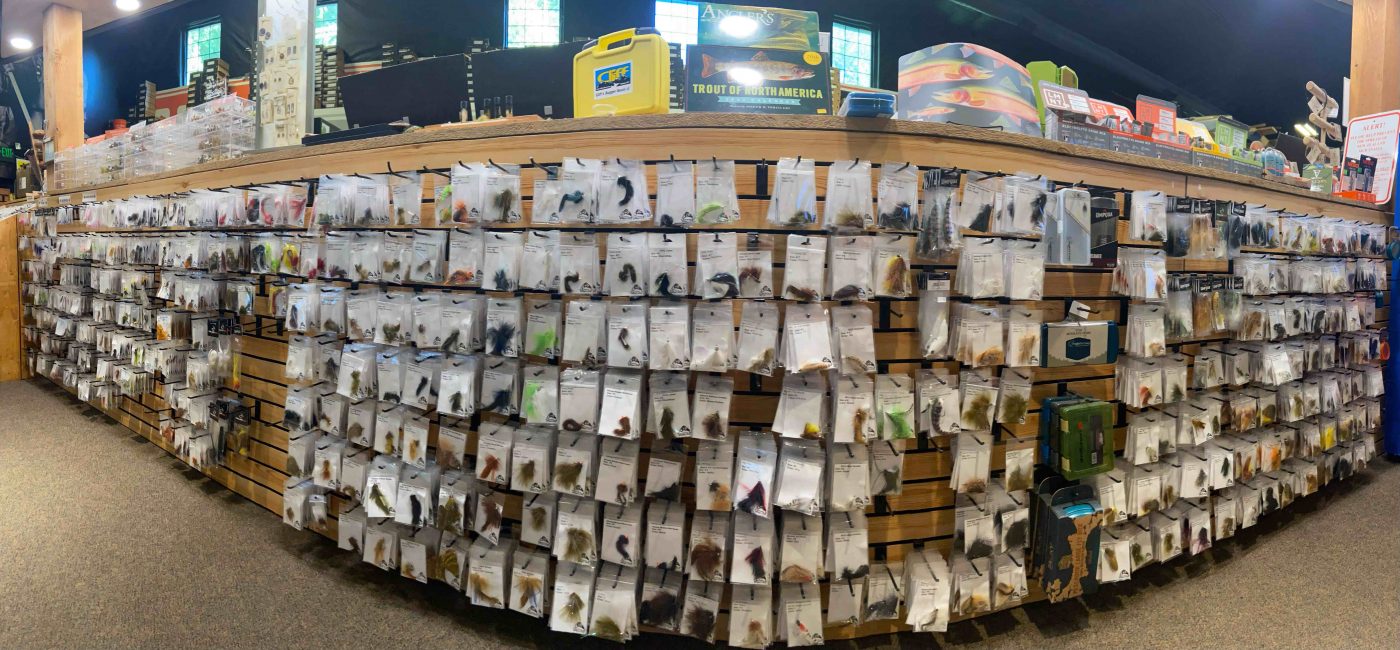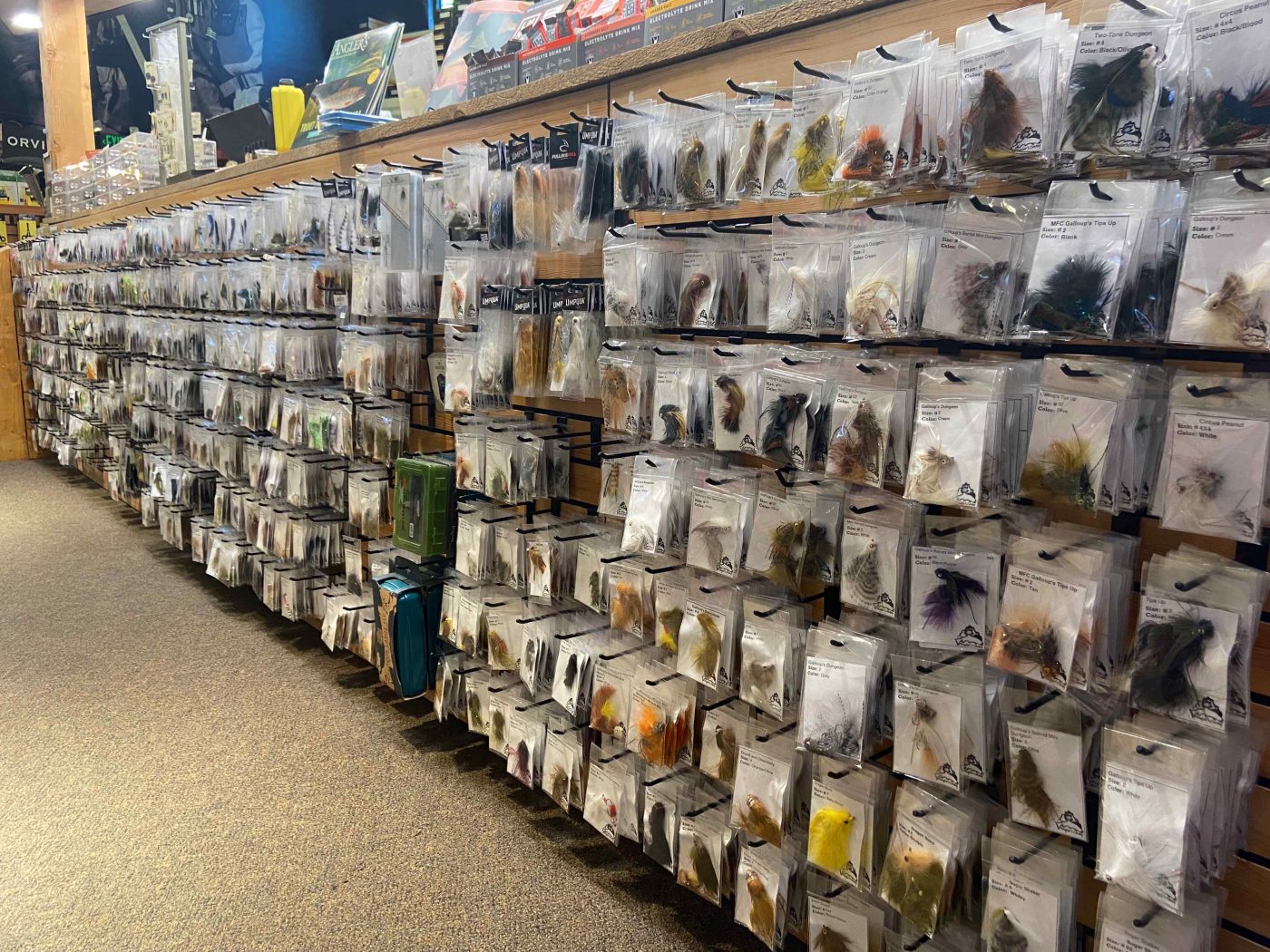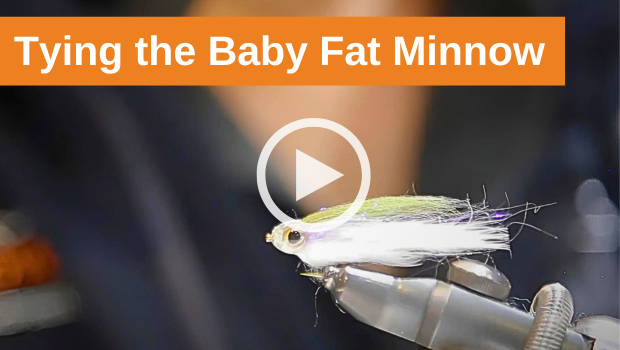Fall Means Streamer Fishing
by Vince Puzick
Facts: Fish chow down before they head into winter doldrums. Little fish have big nutrition, high calories, lots of protein. Big fish eat little fish. September’s focus is on streamer fishing for our “bug of the month”.
The Low-Down on Streamer Fishing
Trout are a territorial and predatory species. The key with streamer fishing is to tap into that predator response rather than just the territorial response. Large brown trout may move to chase a smaller fish out of his territory. What we want to achieve is the predator response: committing to eat our offering.

Tips and Techniques for Fishing with Streamers
Streamer fishing is probably the most active version of fly fishing. By actively retrieving the streamer through a section of river, the angler is almost always doing something with the line.
Placement
One key element to fishing with streamers is placement. You want to get that fly to travel next to structure: big rocks, logs, bridge posts, undercut banks. If I am fishing the bank across from me, I want to place that streamer within six inches of it. You know the place: where that big brown is lurking. Whether you are fishing close to the bank or to structure in mid-river, pick your target and make a cast upstream to allow time for the streamer to sink.
Casting
Casting streamers is different, too, from fishing with dry flies that call for a delicate placement. With dry flies, the weight of the line carries the weightless fly into the cast.
Streamers are heavy and casting them calls for an adjustment. The pattern itself, due to its weight, is sufficient weight to get onto the water. Loading the rod doesn’t always require a back cast. With enough tension on the pattern, an angler can generate enough energy to cast the streamer. That tension can be created by pointing the tip of the rod in the air, leaving the streamer in the water, and then making a modified roll cast. Finish your cast with the tip a little higher in the air than you might normally cast. This allows the heavier fly to go a little further and can avoid a loud “splash landing” that may spook the fish. Casting your streamer about 45 degrees upstream allows the fly time to sink and once it is paralell with you, or 45 degrees downstream, start stripping/retrieving the fly.
Movement
Successfully fishing with streamers means getting effective movement of the pattern.
The Strip. After you make the cast, let the streamer sink. It might be helpful to count to five before you start stripping the pattern through the water. Your strip should be about 4”-6” of line at a time. Imagine strumming a guitar with a pick and make that same motion, pulling line back to you.
Strip and Pause. With streamers, you are imitating small bait fish, the prey, and their movement. After you cast, pause 3-5 between strips (or longer if you are fishing a deep hole). This allows the streamer to sink, then jig off the bottom, then sink again.
Swing It. Begin with a cast slightly downstream and in water closer to you. The downstream direction will allow the streamer to drift in the current and swing back toward the near bank. Often times, the strike will occur at the end of the drift when the pattern begins to lift in the water.
A Combo of Techniques for Streamer Fishing
Swing and Strip. As the streamer nears the end of the drift, make short, quick strips. This quick movement at the end of the drift triggers the predatory instinct in big fish. Anglers can use this technique in a variety of situations. If there is a submerged rock mid-river, move upstream and make a cast upstream of the rock, let it drift to just downstream of it, and then make some quick strips to trigger that brown trout behind that rock. Another strategy is to let the pattern make its drift until it is parallel to the bank and downstream from you. Make a series of strips to lure the fish hugging the bank. I’ll oftentimes jiggle the end of my rod tip to give the pattern a more erratic movement in the water like it is injured.
Other Considerations (mostly dependent on personal preference and where you intend to streamer fish)
Articulated Streamers. Many streamer patterns are articulated patterns with a second hook tied to the first hook. Articulated streamers add two distinct advantages over single-hook varieties. The first benefit is additional movement. The break between the two hooks allows for a motion that almost looks like a small fish moving through the water. The second benefit is a little added length to the pattern. Oftentimes, fish will “short strike” the streamer — hitting the material extending a little beyond the bend in the hook. Articulated streamers increase the chances of a hook-up.
A Second Streamer. The first time I with a two-streamer rig was floating the Gunnison. The guide tied on a darker streamer then followed that with a white Wooly Bugger. It helps with determining whether fish are keyed on dark or light versions. I have fished a two-streamer set-up on the Arkansas and in Elevenmile Canyon, too. I usually tie on that second pattern with 10-12″ of tippet.
Stillwater. In these last few weeks of fall before access ends to our local reservoirs, why not go throw some streamers? While it is possible to fish from the bank (I have plenty of times at North Catamount), fishing from a watercraft offers some great opportunities to get an aggressive pike to the net.
Rod, Line, and Leader Choices
Rod selection. I have fished streamers with my usual 9′ 5-weight rod. Some anglers drop down in length and up in weight. Something like an 8’6″ 6 weight rod is not out of the question. Some fish a 9′ rod but go with a 6 weight.
Fly Line types are dependent on where you are going to streamer fish. On my 9′ 5-weight, I have fished it with a floating line. I didn’t have more than two rods, so I had to stick with what I had. When I committed a rod to streamer fishing, I chose to get a sink tip line. Personally, I didn’t think that a full sink line is necessary for our local rivers. For reservoir streamer fishing, especially when stalking big Pike, going with a full sinking line is a great bet.
Leaders. Put away anything smaller than 4x. 3x is doable. 2x is preferred. In fact, if you have some 9 foot 4x or 5x on the reel that you are going to use for streamer fishing, cut off 4 feet of the tapered end and go with that shortened leader. Because of the nature of casting, presenting the pattern to fish, and the weight of the streamer, you can go short and thick. A great tool to have is a Versileader. These are weighted leaders that allow you to turn your regular floating line into a sink-tip line to aid in getting your fly down fast.
Note: You can see that techniques and gear are going to vary. Come into the Shop to talk specifics for your destination.
Check out this video with Tom Rosenbauer for more techniques on streamer fishing.
Streamer Patterns

Over the last few years, there has been a proliferation of streamer patterns. For our fisheries in the Pikes Peak region — the South Platte and the Arkansas, in particular — a couple of patterns stand out. You can also always check out our Fishing Reports for conditions and for recommended patterns for our local waters.
A couple of things to consider when choosing streamers.
Color matters. You are imitating bait fish so colors are going to range from black, to green, to tan, to white. I have, on occasion, swapped out a white Wooly Bugger for an olive and that made all the difference.
Size matters. The size of the streamer really depends on the pattern choice. I will carry Wooly Buggers from size 8 to 12. I will go larger, a size 4, with Meat Whistles and Laser Legal. Come into the shop and talk with our professional staff because your choices may vary depending on your destination.

Tying Streamers
With so many options from which to choose, here is a great video on one to tie yourself. Tie the Baby Fat Minnow along with Covey Guide Hans Mylant:
More Info?
Come into the shop and talk it up with our professional staff. Streamer fishing is a great option for fall as fish are bulking up on protein for their winter doldrums. Watch our Calendar for fly tying classes so you can tie up your own streamer patterns.


Great information! For someone who doesn’t have much experience with streamers, this is really going to help! I’m excited to go out and try some streamers soon. Great tips. Thanks for everything!